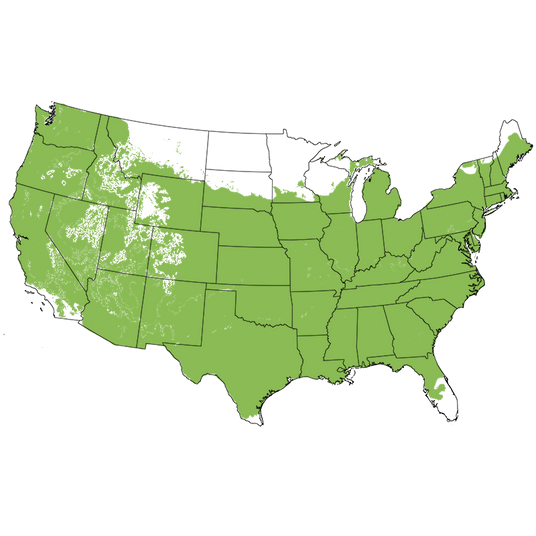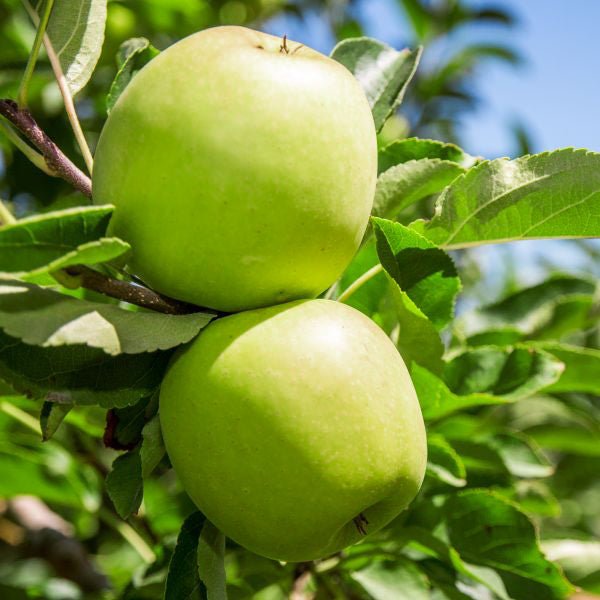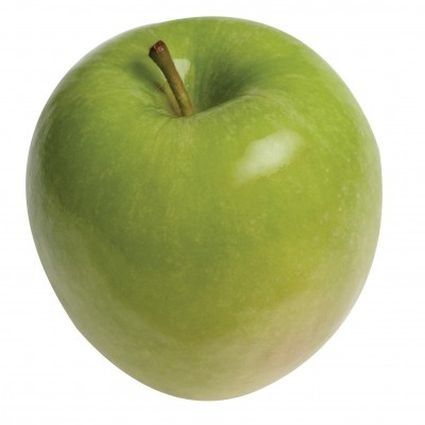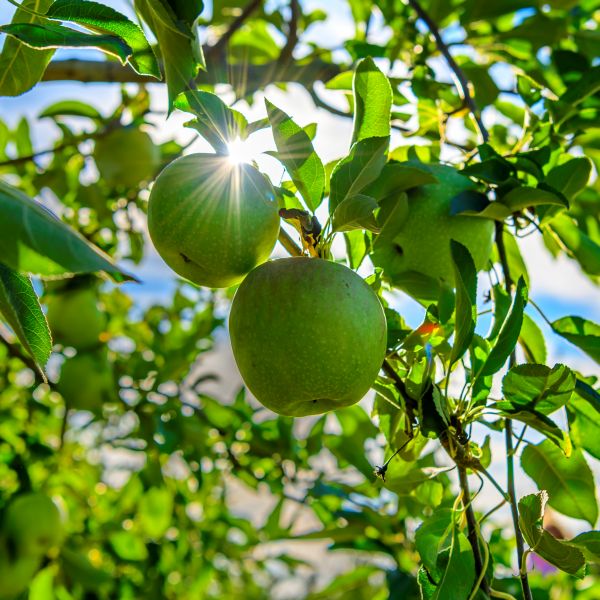Granny Smith Apple Tree
Malus 'Granny Smith'
Plant Sentry™
Plant Sentry™

Plant Sentry™ Protected
Your order is protected by our compliance system that:
- Prevents restricted plants from shipping to your state
- Ensures plants meet your state's agricultural requirements
- Protects gardens from invasive pests and diseases
Delivery and Shipping
Delivery and Shipping
Delivery and Shipping
Fast, Safe Plant Delivery
Ships in 3-4 business days • Tracking provided • Weather protected
| Under $50 | $9.99 |
| $50 - $99.99 | $14.99 |
| $100 - $149.99 | $16.99 |
| $150 - $198.99 | $24.99 |
| $199+ | FREE |
✓ Zone-specific timing • ✓ Professional packaging • ✓ Health guarantee
Understanding Plant Options
Nature Hills offers plants in two main formats:
- Container Plants: Grown in pots with soil, sized by container volume and plant age
- Bare Root Plants: Dormant plants without soil, sized by height measurements
Container Plant Sizes
Container sizes indicate plant age and growing capacity rather than liquid volume equivalents. Our containers follow industry-standard nursery "trade gallon" specifications, which differ from standard liquid gallon measurements.
Young Plants (6 months to 18 months old)
| Container Size | Actual Volume | Metric Equivalent |
|---|---|---|
| 2" x 2" x 3" | 0.18 - 0.21 dry quarts | 0.20 - 0.23 dry liters |
| 4" Container | 0.31 - 0.87 dry quarts | 0.35 - 0.96 dry liters |
| 4.5" Container | 0.65 dry quarts | 0.72 dry liters |
| 6" Container | 1.4 dry quarts | 1.59 dry liters |
| 1 Quart | 1 dry quart | 1.1 dry liters |
| 5.5" Container | 1.89 dry quarts | 2.08 dry liters |
Established Plants (18 months to 2.5 years old)
| Container Size | Actual Volume | Metric Equivalent |
|---|---|---|
| 2 Quart | 2 dry quarts | 2.2 dry liters |
| #1 Container | 2.26 - 3.73 dry quarts | 2.49 - 4.11 dry liters |
| 5" x 5" x 12" | 3.5 - 4.3 dry quarts | 3.85 - 4.74 dry liters |
Mature Plants (2-4 years old)
| Container Size | Actual Volume | Metric Equivalent |
|---|---|---|
| #2 Container | 1.19 - 1.76 dry gallons | 5.24 - 7.75 dry liters |
| #3 Container | 2.15 - 2.76 dry gallons | 8.14 - 12.16 dry liters |
Large Plants (3-5 years old)
| Container Size | Actual Volume | Metric Equivalent |
|---|---|---|
| #5 Container | 2.92 - 4.62 dry gallons | 12.86 - 20.35 dry liters |
| #6 Container | 5.25 - 6.01 dry gallons | 23.12 - 26.42 dry liters |
| #7 Container | 5.98 - 6.53 dry gallons | 26.34 - 28.76 dry liters |
Bare Root Plants
Bare root plants are sold by height from the root system to the top of the plant. Plants may exceed minimum height requirements.
Common Sizes:
- Trees: 1 foot, 2 feet, 3 feet, 4 feet, 5 feet, 6 feet
- Shrubs & Perennials: 1 foot, 18 inches, 2 feet
Important Notes
Container Volume Specifications
- Trade Gallon Standard: Our containers follow industry-standard "trade gallon" specifications established by the American National Standards Institute (ANSI Z60.1) for nursery stock
- Volume Variations: Actual soil volume may vary due to plant root systems and growing medium settlement
- Age Indicators: Container size primarily indicates plant age and maturity rather than liquid volume equivalents
Growing Conditions
- Plant size can vary based on variety and growing conditions
- Container size helps indicate plant maturity and establishment level
- Larger containers generally mean more established root systems and faster landscape establishment
Seasonal Availability
- Bare root plants are available seasonally when dormant
- Container plants are available throughout the growing season
- Specific varieties may have limited availability in certain sizes
Questions?
For questions about specific plant sizes or availability, please contact our plant experts who can help you choose the right size for your landscape needs.

Plant Sentry™ Protected
Your order is protected by our compliance system that:
- Prevents restricted plants from shipping to your state
- Ensures plants meet your state's agricultural requirements
- Protects gardens from invasive pests and diseases
Plant Profile & Growing Essentials
Cold hardy, Flowering, Edible, Ornamental Berries/Fruit, Attracts pollinators, and Thornless
Specifications
Specifications
-
Botanical Name
-
Height
-
Width
-
Growing Zones
-
Sunlight
-
Growth RateModerate
-
Flower Color
-
Leaf Color
-
Fall Color
-
Pollinator FriendlyYes
-
Pollinator Required
-
Harvest Time
-
Bloom PeriodLate Spring
-
Does Not Ship ToAK, CA, HI, ID, MT, OR
Planting & Care Instructions
Planting & Care Instructions
A Tart Favorite For Apple-Lovers - Granny Smith Apple Tree!
- Popular Green-Skinned Baking Apple
- Crisp Greenish-White Flesh
- Delicious Tart Apples
- Perfect Baking Apple - Holds Shape Well!
- Won’t Brown Quickly Once Cut
- Long-Lived Tree
- Heat Tolerant
- Reliable Fruit Production
- Vigorous Growth
- Late Season Harvest
- Self-Fertile But Pairs With Fuji, Ginger Gold & Honeycrisp
- Cooking & Baking, Pies, Fresh Eating & Cider
- Stores 6 Months!
- ~400 Chill Hours
One of the best-known apple varieties for both cooking and snacking, Granny Smith Apple Tree (Malus 'Granny Smith') enjoys a long history of embodying an apple with exceptional tartness for fresh eating and baking qualities!
The juicy, white flesh is likewise energizing, with a crisp, tart flavor that's perfect for award-winning pies, culinary dishes...or just right off the tree!
Its lovely, light-green skin (occasionally with a subtle, pink blush), presents a vibrant sight amid the branches in October. The greenish-white flesh is crisp and juicy!
Holding its shape amazingly when cooked makes this a traditional pie apple, but also for all baking purposes, fresh eating in fruit salads as well as other culinary uses!
The bright pink buds in spring burst open to white blossoms with pink edges! Pollinators adore these blooms and even an early hummingbird or two will stop by for a visit! Highly fragrant, be sure to snip a few boughs to bring indoors to enjoy springs splendor in a vase arrangement!
An antique selection in cultivation since 1868 where it was a chance discovery by Maria Ann “Granny” Smith on her orchard in Australia.
The Granny Smith Apple tree is a fruit tree that produces high-quality, tart green apples on a reliable tree. Plant one in a sunny location and watch your harvest grow!
Storing remarkably well, these fruits remain crisp in cold storage or refrigeration for up to 6 months!
How to Use Granny Smith Apple Tree In The Landscape
Granny Smith apple's high acid content means that they won't go brown as quickly once cut, so they're especially valued for fruit trays and salads.
Granny Smith apples are also chocked full of vitamins and antioxidants, but not calories, so they're a great way to encourage good health! Pack one with lunch for a healthy snack on the go, or slice up for a tart addition to your wine and cheese board!
Great juicing and for cider, try your hand at making some home-brewed bubbly! You’ll have a large enough crop in a short time to try using Granny Smith for all your favorite recipes!
The fragrant pink and white blooms are gorgeous additions to a cottage and perennial gardens, plus they’re welcome shade trees, perfect around your patios and vegetable gardens!
Plan a spring picnic beneath the blooms and watch the pollinators buzz from blossom to blossom! It’s a perfect destination spot among a field of wildflowers.
Also modestly sized and you can prune even smaller if desired for a fruit tree that will work in any smaller sized urban yard or small orchard!
Try your hand at training this tree as Espalier for a truly unique focal point tree that saves space!
Gorgeous specimen plants when in full bloom or dripping with fruit, these are lovely landscaping trees for privacy, property definition, and sized wonderfully for home orchards and edible landscaping!
Line your property with blooms and privacy you, and your neighbors, won’t mind viewing! Anchor and shade smaller trees or shrubs in larger planting sites, or just add this fantastic variety to your orchard!
#ProPlantTips For Care
A tip-bearing apple tree, Granny Apples are vigorous, late-season apples. Harvest time generally is late October. Heat tolerant and hardy in growing zones 5-9.
Apple trees need full sun for the most blooms and best fruit, and also require well-drained soils. However, they’re not particular on the type of soil so long as it is well-drained and organically enriched. Not minding acidic soil, these are drought-tolerant once established. However, protect your investment with regular watering and consistent moisture for the best, juiciest crop!
These reliable producing apples bear fruit between 3-5 years of age and Nature Hills ships your landscape grade trees already 3 years old! This way, it won’t be long before you harvest your first crop.
Mulch the surface of the root system for the most moisture retention and also to insulate the roots from heat and chill.
Prune when dormant to open the canopy and allow sunlight and air circulation. Fair disease resistance, be sure to thin the crop for larger fruit.
It tends to be a strong-limbed tree, able to manage its harvest without the need for additional supports. It can be long-lived under optimal conditions and is quite heat tolerant.
If you love a tart apple, or just enjoy one with good storage and a variety of culinary uses, Granny Smith is the perfect apple for you! There’s nothing quite like picking your own, homegrown fruit from a tree you grew! The flavor is incomparable!
Order your own antique, tried-and-true variety of Apple Tree from NatureHills.com today!
Although self-fertile, you can also pair with: Fuji, Ginger Gold & Honeycrisp
Granny Smith Apple Tree Frequently Asked Questions
When to Plant Granny Smith Apple Trees
Planting Bareroot trees as soon as you can dig a hole in spring and until hot weather, the earlier the better. Plant container Apple trees throughout the growing season with complete success - that is the benefit of container plants - to extend the planting season. Your County Agricultural Extension Office is a great resource for first and last frost dates in your area.
How to Plant Granny Smith Apple Trees
Dig a large hole only as deep as needed to accommodate the bareroot or container root ball, and twice as wide. Add Nature Hills Root Booster to speed root establishment. Remove the pot or bag and situate it into the hole so the top of the soil (soil line if bareroot), is level with the new location's soil being careful not to plant too deep. Water in again very well and backfill with the same soil you dug up, tamping down gently to ensure there are no air pockets.
Top off with a 3-4 inch thick layer of Arborist mulch. Consider staking your tree to keep its trunk growing straight for the first year to ensure it stands tall against strong winds and drifting snow.
When to Prune Granny Smith Apple Trees
Trim off any broken branches from delivery as soon as you take them out of the box. Prune and trim apple trees while dormant, in late winter or early spring, before you see new growth.
How to Prune Granny Smith Apple Trees
Dormant prune to:
- Remove any double leaders or narrow crotch angles
- Eliminate any crossing branches
- Thin interior branching and leave the fruiting spurs and strong branches in place opening up the canopy
- Branching at least 24-36 inches above the ground
Prune Apple trees in the summer to:
- Control size and shape by reducing the length of longer new growth on vigorous trees
- Remove water sprouts on the main trunk or older branches in the crown
- Remove suckers at the base of the trunk
- Thin fruit during heavy years on established trees
How to Care for Granny Smith Apple Trees
Growing an apple tree is easy when proper soil, good drainage, attention to moisture, and regular fertility are maintained. Once you've chosen an apple tree that works for your climate, in the size you need for your landscape, and its pollinator (if needed), then you've accomplished half the battle!
- Apple trees do best in full sun and well-drained soil
- Water your apple trees when it gets dry - especially during the fruit production stage, and drought periods to keep it stress-free
- Use arborists' wood chips to mulch over the roots of your apples and have your soil tested to see what your soil may be lacking before adding fertilizers
- Maintenance pruning and shaping
Apple trees will tolerate a wide range of soils, so long as water and nutrients are not limited and the pH level is adequate.
How to Fertilize Granny Smith Apple Trees
For the first year, water alone is most important. It is always best to get a soil test to see what your soil is lacking before adding more fertilizers. Once established, a fertilizer routine may be beneficial. We do offer some excellent slow-release organic options, applied according to the package directions.
Fruit trees need more phosphate and it's possible to apply too much nitrogen which affects the soil's pH. Test soil acidity or alkalinity using a pH Tester.
Fertilize in spring when you first see new growth emerging.
- Don't overdo it
- Phosphates are your friends
- Pay attention to pH in areas with extremely high or low soil pH
- Follow the directions
Granny Smith Apple Tree Pollinating Info
Granny Smith is self-fruiting and doesn't need a pollinating partner, but will bear more fruit when paired with these varieties:
Harvest Times for Granny Smith Apple Trees
Granny Smith’s are typically ready to harvest in October.
Early-Season? Mid-Season? Late-Season? The terminology can be confusing for new apple tree growers. Weather, climate and your tree determine when it's ripe.
For Apples:
- Early-season is usually June-July
- Mid-season can be August-September
- Late-season can be from late September-November
The growing season consists of spring, summer, and fall, and varies with climate and weather. Areas with longer growing seasons in the warmer hardiness zones can greatly affect the harvest times for each particular apple variety grown in your area. Learn which growing zone you are in.
What Shipping Options Do You Offer?
NatureHills.com works closely with our growers and nursery professionals to ensure we ship when it is most appropriate for your area. Our goal is to deliver the hardiest plants by avoiding extreme high and low temperatures. Check out our shipping schedule for more information and to learn our wills and won'ts when it comes to shipping plants. Find your Granny Smith Apple Tree for sale here at NatureHills.com!
Rootstocks Explained
Apple trees have been grafted onto different rootstocks since before the mid-1800s. Different rootstocks are used to improve the anchoring of trees, eliminate diseases, and reduce the natural mature size of the tree itself. While there are many different types of rootstock, they are all labeled as being either Dwarf, Semi-Dwarf, or Standard.
The apple descriptions, including flowering, pollination, and apple characteristics are the same whether the plant is grown on a standard rootstock or some varying dwarfing rootstock. The overall size can vary by climate and soil but the understock used is ultimately what affects the mature size.
There will be some variation in sizes but as a guide, we are suggesting the overall mature size of these apple varieties are:
Semi-Dwarf Apples
- Height: 12-18 feet
- Spread: 10 - 15 feet
Standard Apples
- Height 18 - 25 feet
- Spread: 15 - 18 feet
Remember that all fruit tree sizes can easily be altered if needed by simple pruning as the trees grow and develop.
Granny Smith Apple Superior for Cooking
The Granny Smith Apple, possibly one of the most versatile apples ever discovered, was truly a miracle. Marie Ann Smith and husband Thomas of Eastwood New South Wales, Australia, owned a small orchard in this area well-known for fruit production. Out of their orchard, Marie would sell fruit to the Sydney market and became well-known for her baked goods through the years.
As the story goes, Marie had purchased some French Crabapples reportedly grown in Tasmania at the market for use in a recipe. She discarded the cores in a compost pile either outside her kitchen window or beside a creek close to the home.
A seedling emerged from this discarded fruit that Marie let grow until it fruited. This seedling, it is speculated, was a cross between the Malus sylvestris (European Wild Crabapple) and Malus pumlia (Domestic Apple). She found the fruit to be perfectly suited for cooking and eventually realized, when left on the tree, this green cooking apple turned yellow and became a fine, fresh eating apple.
It is said that she planted a few more of this variety and began to take the apples to market where they were an immediate hit.
In 1868 she began to invite local growers to view this new variety. Marie, in her later years, had become known to the locals as Granny Smith and her exciting new apple became known as Granny Smith Seedling. Marie Ann Smith, or Granny Smith, unfortunately passed in March of 1870.
However, Edward Gallard, one of the local growers, had by this time planted an entire orchard of the Granny Smith Seedlings and eventually, after the death of husband Thomas in 1876, bought the Smith farm and began selling to a wider market.
In 1890, after being featured at a well-known horticultural trade show at Castle Hill, Granny Smith won top honors and in 1895 was secured by the New South Wales Government Experimental Station, where the Australian Government picked up testing. Granny Smith proved to have superior storage qualities and gained fast recognition for its long shelf life and high-quality fruit.
After the First World War, Granny Smith exports grew tremendously and still more after the Second World War. By 1975 Granny Smith was reported to have made up 40% of the apples grown in Australia. Today, Granny Smith is one of the top 5 apples grown throughout the world.

















